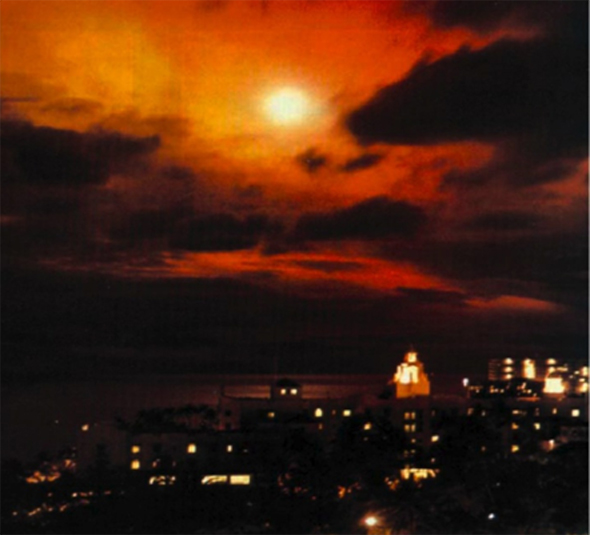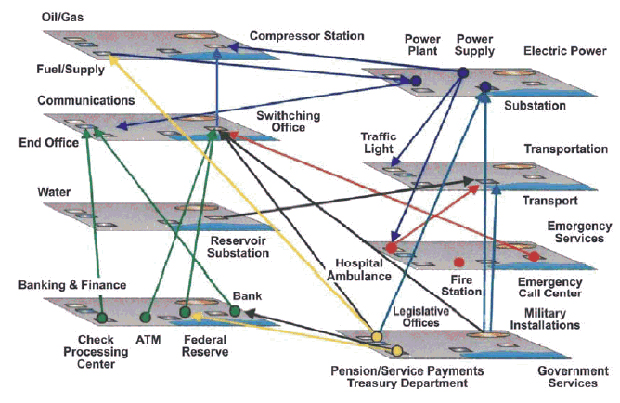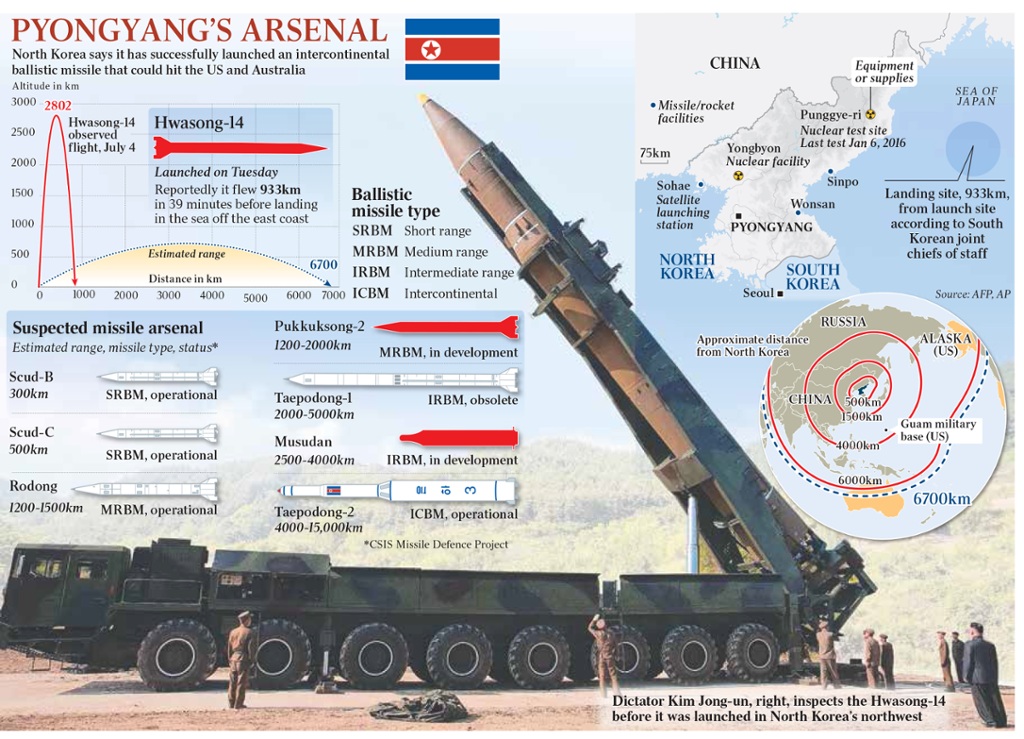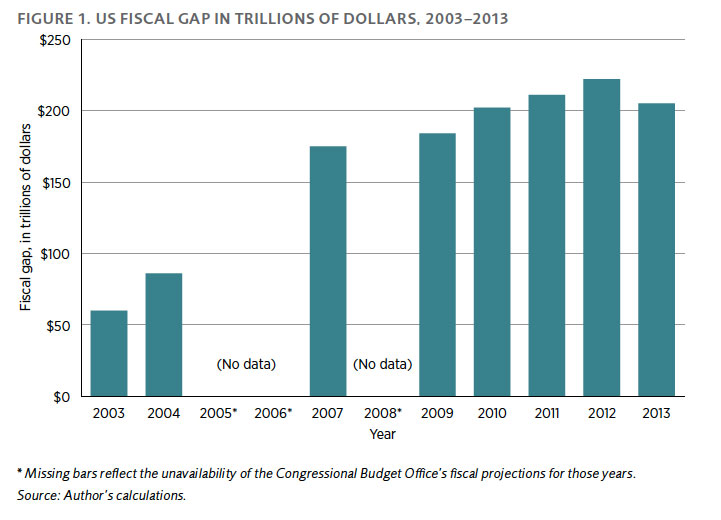 Chapter 2 of my book: Physical and Financial threats to the West
Chapter 2 of my book: Physical and Financial threats to the West
The Islamic nuclear threat
At least two Islamic states have nuclear capabilities. The radical Islamic state of Iran is close to producing nuclear weapons, with which it has promised to obliterate the state of Israel.
The Islamic state of Pakistan is heading towards failed-state status, with the Taliban and other radical groups openly attacking Pakistani airports, ports, and cities. Parts of Pakistan consist of ungovernable radical Islamic areas.
Pakistan’s uranium-enrichment facilities are estimated to be capable of producing 110 kilograms of weapons-grade uranium annually, which is enough for five nuclear weapons. On completion of the fourth reactor at Khusab, Pakistan could also produce 70 kilograms of weapons-grade plutonium each year, enough for 14 weapons.
At a total rate of 19 weapons annually, Pakistan would be one of the world’s larger nuclear powers by 2020, with an arsenal equivalent in size to that of Britain or France.[i]
According to various intelligence sources, Pakistan, by the end of 2015, had between 100 and 120 nuclear weapons under its control. It is believed, however, that Pakistan has produced and stockpiled around 3,000 kilograms of weapons-grade highly-enriched uranium (HEU) and about 200 kilograms of plutonium. The current stockpile is enough for an additional 150 to 200 nuclear weapons.[ii]
That amount of nuclear weaponry in the hands of Islamic radicals doesn’t bear thinking about, particularly when these weapons can be used to launch an electromagnetic pulse (EMP) attack (see Electric Armageddon below).
Islamic State planning “nuclear holocaust” to wipe hundreds of millions from the face of the earth.
In January 2015, Jürgen Todenhöfer, the first Western reporter to embed (for ten days) with Islamic State (IS) fighters and not be killed in the process, discussed his observations of the terror group with the broadcaster, Al Jazeera. “I always asked them about the value of mercy in Islam,” he said, but “I didn’t see any mercy in their behavior.” He added:
Something that I don’t understand at all is the enthusiasm in their plan of religious cleansing, planning to kill the non-believers… They also will kill Muslim democrats because they believe that non-ISIL-Muslims put the laws of human beings above the commandments of God…. They were talking about [killing] hundreds of millions. They were enthusiastic about it, and I just cannot understand that.[iii]
Todenhöfer expanded upon his observations of IS in his book, My Journey into the Heart of Terror: Ten Days in the Islamic State, which was published in April 2015.[iv]
Mr. Todenhöfer went on to say that ISIS has plans for mass genocide, with the aim of eradicating all atheists and religions that are not “people of the book” or who do not subscribe to their particular brand of Islam. He wrote:
The IS want to kill… all non-believers and apostates and enslave their women and children. All Shiites, Yazidi, Hindus, atheists, and polytheists should be killed.
Hundreds of millions of people are to be eliminated in the course of this religious “cleansing.”
All moderate Muslims who promote democracy should be killed. Because, from the IS perspective, they promote human laws over the laws of God.
This also applies to – after a successful conquest – the democratically-minded Muslims in the Western world.
The terror group allowed Jürgen Todenhöfer to embed with them because he has been a high-profile critic of U.S. policy in the Middle East.
The German journalist claimed the terror group wants to launch a “nuclear tsunami” against the West and anyone else that opposes their plans for an Islamic caliphate.
Mr. Todenhöfer warned that ISIS was the most dangerous terror organization he has ever witnessed. “I don’t see anyone who has a real chance to stop them. Only Arabs can stop IS. I came back very pessimistic.”[v]
Since Jürgen Todenhöfer published his book in 2015, the embryonic caliphate that ISIS built in Iraq and Syria has collapsed, fuelling a sense of triumphalism in the West. Many in the West believe that while ISIS may remain a threat in terms of conducting terror attacks abroad, its failure to “remain and expand” on its own territory will eventually deal a decisive blow to its reputation.
Some observers say that this is the wrong conclusion to draw from ISIS’s military defeat. ISIS will most likely frame its military defeat as a victory of some sort. They say that ISIS plans to market defeat within a narrative of hardship, heroism, martyrdom, and “temporary” withdrawal from its territory.
Whichever way you look at it, ISIS will continue to pose a major threat to the West.
While Western governments may think Islamic State’s threats of a nuclear tsunami are just saber-rattling, they should, in my opinion, be taken seriously. As detailed in the EMP threat section below, two innocuous-looking freighters, one off the coast of California and the other off the coast of New York, each firing a super electromagnetic pulse (EMP) device from a Scud missile high into the atmosphere, would cause catastrophic damage to the entire electrical infrastructure of the United States. Such an event has the possibility of sending America back to the pre-industrial age, with the loss of millions of lives, thus realizing the “nuclear tsunami” threat of Islamic State.
In March 2016, Richard Haass, president of the Council on Foreign Relations, a New-York based think tank, warned that North Korea could be poised to sell its nuclear secrets to Islamic State terrorists in a chilling deal that would give atomic weapons to one of the world’s gravest enemies. Mr. Haass believes the cash-strapped state would be willing to give away the deadly information for a price.[vi]
President Obama warns of Islamic State’s nuclear threat
The threat from terrorists trying to launch a nuclear attack is real, and it would “change our world,” former President Barack Obama told a meeting of world leaders at the Nuclear Security Summit in Washington in April 2016.[vii]
The world has taken “concrete” steps to prevent nuclear terrorism, he told the meeting.
But the so-called Islamic State (IS) obtaining a nuclear weapon is “one of the greatest threats to global security,” President Obama added.
More than 50 nations were represented at the summit.
World leaders convening in Washington for the summit also expressed concern about North Korea’s nuclear weapons program and Pakistan’s and Russia’s lack of attendance.
It seems President Obama had the threat of an EMP attack in mind when he warned that a terrorist nuclear attack would “change our world.”
The China threat
A resurgent China (Chapter 3) poses threats to the West at a number of levels: its aggressive military build-up, its threats to trade routes by its attempted dominance of the South China Sea, its cyber threats and its soft-power influence.
China is flexing its military muscles in the South China Sea and its economic muscles worldwide. It has attempted to siege the South China Sea as far south as the Natuna Islands, part of Indonesia. It plans to enforce its claims by building a large fleet of naval vessels badged as coast-guard vessels. Its actions threaten its neighbors, Vietnam, Malaysia, Indonesia, Brunei and the Philippines.
Worldwide, China is using its massive monetary reserves to buy up minerals and large tracts of agricultural land. It has a vast and influential sovereign wealth fund, the China Investment Corporation, which has around $200 billion in assets. In just the first quarter of 2016, Chinese firms spent a massive $98 billion buying up overseas assets in a range of sectors – from agriculture to property, entertainment and mineral resources.[viii]
Chapter 3, Hegemon Rising, deals in detail with the China threat.
Electromagnetic Pulse (EMP) – a truly apocalyptic threat
 When the Starfish thermonuclear warhead detonated at an altitude of 400 km, it made no sound. There was a very brief and very bright white flash in the sky that witnesses described as being like a huge flashbulb going off in the sky. This was the first time the EMP phenomenon was noticed and recorded. Significant damage was done to both civilian and military electrical systems throughout the Hawaiian Islands, over 1,200 km from ground zero.
When the Starfish thermonuclear warhead detonated at an altitude of 400 km, it made no sound. There was a very brief and very bright white flash in the sky that witnesses described as being like a huge flashbulb going off in the sky. This was the first time the EMP phenomenon was noticed and recorded. Significant damage was done to both civilian and military electrical systems throughout the Hawaiian Islands, over 1,200 km from ground zero.
What is EMP?
An electromagnetic pulse (EMP) is a super-energetic radio wave that can destroy, damage or cause the malfunction of electronic systems by overloading their circuits. An EMP is harmless to people biologically, passing through their bodies without injury, like a radio wave.
But by damaging the electronic systems that make modern society possible, an EMP can cause mass destruction of property and life.
A single nuclear weapon detonated at high altitude over any country, or say, central Europe, will generate an electromagnetic pulse that can cause catastrophic damage across a radius of 2,000 to 3,000 kilometers to the critical infrastructure – electric power, telecommunications, transportation, banking and finance, food and water – that sustains modern civilization and the lives of millions of citizens.
Because an EMP attack requires the detonation of a nuclear warhead at high altitude, no other nuclear effects – such as blast, thermal radiation or radioactive fallout – would be experienced by people on the ground.
However, because modern civilization and life now depend upon electricity and electronics, an EMP attack is a high-tech means of killing millions of people the old-fashioned way – through starvation, disease and societal collapse.
Official sources estimate that if a high altitude EMP device was exploded over the United States, up to 200 million people would perish within 12 months.[ix] An EMP attack would send America back to the pre-industrial age – no electricity, no running water, no transport, no banking and finance, no credit cards, and after a few days – no food.[x]
The threat of societal breakdown
If governments lose the ability to maintain order, civil society would quickly break down.
Sadly, in modern times, it doesn’t take much to trigger societal breakdown.
A small taste of societal collapse occurred when lightning caused a power blackout in New York on July 13, 1977.
TIME Magazine described New York’s blackout in 1977 as a “Night of Terror.” Widespread chaos reigned in the city until power was restored – entire blocks were looted and set ablaze, people flipped over cars and vans on the streets; the city was in pandemonium. That night, 3,776 arrests were made, and certainly not all looters, thieves and arsonists were apprehended or arrested.[xi]
On streets like Brooklyn’s Broadway, the rumble of iron store gates being forced up and the shattering of glass preceded scenes of couches, televisions and heaps of clothing being paraded through the streets by looters, at once defiant, furtive and gleeful. Thirty-five blocks of Broadway were destroyed, and 134 stores were looted with 45 of them set ablaze.
Power was restored the next day.
Imagine if the power was out for one month or one year.
2011 London riots
Another example of societal breakdown occurred in England between August 6 and 11, 2011. Thousands of people rioted in several London boroughs and in cities and towns across England. The resulting chaos generated looting and arson, leading to the mass deployment of police and the death of five people.
Disturbances began on August 6 after a protest in Tottenham, London, following the death of Mark Duggan, a local black youth who had been shot dead by police on August 4. Several violent clashes with police ensued, along with the destruction of police vehicles, a double-decker bus, and many homes and businesses, thus rapidly gaining attention from the media.
Overnight, looting took place in Tottenham Hale Retail Park and nearby Wood Green. The following days saw similar scenes in other parts of London, with rioting taking place in Hackney, Brixton, Walthamstow, Peckham, Enfield, Battersea, Croydon, Ealing, Barking, Woolwich, Lewisham and East Ham.
From August 8 to 10, other towns and cities in England (including Birmingham, Coventry, Leicester, Derby, Wolverhampton, Nottingham, West Bromwich, Bristol, Liverpool, Manchester, and Salford) saw what the media described as “copycat violence.”
Vehicles, homes, and shops were attacked and set alight. At least 100 homes were destroyed in the arson and looting. Shopkeepers estimated the damages in their Tottenham Hale and Tottenham branches at several million pounds.
The riots also caused the irretrievable loss of heritage architecture. It was estimated that retailers lost at least 30,000 trading hours. The Association of British Insurers said they expect the industry to pay out in excess of £200 million.
By August 15, more than 3,000 arrests had been made across England, with more than 1,000 people issued with criminal charges for various offenses related to the riots. Initially, courts sat for extended hours.
There were a total of 3,443 crimes across London linked to the disorder. Along with the five deaths, at least 16 other people suffered injuries as a direct result of related violent acts. An estimated £200 million worth of property damage was incurred, and local economic activity was significantly compromised.[xii]
Is this science-fiction stuff or is it a real threat?
In the U.S. an official consensus exists about the EMP threat assessment above. Two Congressional commissions, the National Academy of Sciences and two other U.S. government-sponsored major studies have all independently examined the threat and arrived at the same conclusion – that an EMP is a potentially catastrophic threat that demands high priority be given to preparedness.
Much of the information in this book was derived from the findings of a congressionally mandated EMP commission in the United States, which ran from 2002 to 2008.[xiii]
No lesser a figure than the former Speaker of the U.S. House of Representatives, Newt Gingrich, has warned of the extreme consequences of an EMP attack. In a speech delivered at the National Defense University, Washington, DC, on December 14, 2016, Gingrich declared that:
… [E]lectromagnetic pulse is the largest, single threat to our civilization. It’s absurd how little we spend on coping with it, because if you harden enough, it’s not a threat; but if you don’t harden enough, and we get hit with an electromagnetic pulse, your civilization collapses.[xiv]
How would you know if an EMP attack had occurred?
You could be driving your automobile and it suddenly stops and refuses to re-start. You get out your mobile phone to call for help but notice there is no signal. You begin walking home and notice other vehicles stalled along the road. You finally reach home to find it blacked out – no lights, no TV and the refrigerator not working.
You then discover there is no running water and, after the first flush, the toilet does not refill. Even though you have solar panels on the roof, you discover that when the grid goes down the solar system automatically switches off. You switch on a battery-powered radio to hear a government message exhorting you to stay calm and that the power will be restored as soon as possible.
The truth is, power may not be restored for months or even years.
Among the vulnerabilities of the electricity grid are devices known as extra high voltage (EHV) transformers that send electricity over long distances. These devices can be as large as a house and weigh hundreds of tonnes. Many EHV transformers would probably burn out in an EMP attack. Even a few failures would cause catastrophic cascading effects on the electricity system. They are only manufactured in a few places in the world and must be custom-built. Worldwide production capacity is less than 100 units per year and serves a world market, one that is growing at a rapid rate in countries such as China and India. Delivery time of a new transformer ordered today is nearly three years, including both manufacturing and transportation. An event damaging several of these transformers at once means it may well extend delivery times well beyond current rates.
Another key vulnerability is the widespread use of robots of the modern age known as Supervisory Control and Data Acquisition (SCADA) systems. SCADAs are essentially small computers, numbering in the hundreds of thousands, ubiquitous in the critical infrastructure that performs jobs previously completed by hundreds of thousands of human technicians during the 1960s and earlier. They find extensive use in critical infrastructure applications such as electrical transmissions and distribution, water management, and oil and gas pipelines. Because they are sensitive electronic devices, SCADAs are especially vulnerable to an EMP.
Who has EMP weapons?
The United States EMP Commission found that Russia, and most probably China and North Korea, are already in possession of such weapons. The EMP Commission also found, contrary to the claim that high-yield nuclear weapons are necessary for an EMP attack, that in fact very low-yield nuclear weapons of special design can produce significantly more EMP than high-yield nuclear weapons. Russian writings call these “Super-EMP” nuclear weapons.

Connections and interdependencies across the economy
Source: Department of Homeland Security
Yet a Super-EMP warhead could have a tiny explosive yield, perhaps only a few kilotons, because it is specially designed to produce primarily gamma rays that generate the electromagnetic shock wave.
In 2004, credible Russian sources warned the EMP Commission that design information and a “brain drain” from Russia had transferred to North Korea the capability to build a Super-EMP nuclear weapon “within a few years.” In 2006, 2008 and again in 2016, North Korea tested a nuclear device of very low yield and declared these tests successful. Just after the 2016 test, North Korea tested a long-range missile capable of delivering a Super-EMP warhead.
North Korea’s proclivity to sell missiles and nuclear technology to fellow rogue nations, Iran and Syria, makes their possession of Super-EMP nuclear weapons especially worrisome. Further, Islamic State boasted in 2015 that it expects to have a nuclear weapon “within a year.”[xv]
Who would launch an EMP attack?
 North Korea, Iran and the Islamic State each have an implacable hatred of the United States. Either one or perhaps more than one, in combination, would have the motivation and capability to launch an EMP attack.
North Korea, Iran and the Islamic State each have an implacable hatred of the United States. Either one or perhaps more than one, in combination, would have the motivation and capability to launch an EMP attack.
The attack could be launched via a North Korean long-range missile. However, the Americans could trace the source of such an attack and carry out retaliation.
A more likely scenario is for an attack using a short-range missile launched from a freighter off the coast of California or New York. Any missile, including short-range missiles, that can deliver a nuclear warhead to an altitude of 40 kilometers or more, can make a catastrophic EMP attack on a target country, by launching from a ship or freighter. Iran has practiced ship-launched EMP attacks using Scud missiles – missiles that are possessed by scores of nations and even terrorist groups.
An EMP attack launched off a ship with a Scud, and a warhead detonated at high altitude would leave no bomb debris for forensic analysis, enabling rogue states or terrorists to destroy critical infrastructure and kill millions of Americans anonymously.
The EMP threat from North Korea entered new and even more dangerous territory in April 2017 when North Korea’s psychopathic dictator, Kim Jon-un threatened all-out nuclear war against the United States if it dared attack his nuclear facilities. The media and U.S. authorities dismissed Kim’s threat as just saber-rattling by a deranged fool.
The United States and indeed the Western world, dismiss Kim’s threats at their peril.
On February 7, 2016, North Korea launched a second satellite, the KMS-4, to join their KMS-3 satellite launched in December of 2012. In an article in the Washington Times on April 24, 2016, R. James Woolsey, former director of the Central Intelligence Agency, and Peter Vincent Fry, executive director of the Task Force on National and Homeland Security as well as director of the Nuclear Strategy Forum, both congressional advisory boards, warned of the dangers of an apocalyptic EMP attack that these and similar satellites pose:
Both satellites now are in south polar orbits, evading many U.S. missile defense radars and flying over the United States from the south, where our defenses are limited. Both satellites – if nuclear-armed – could make an electromagnetic pulse (EMP) attack that could blackout the U.S. electric grid for months or years, thereby killing millions.
Technologically, such an EMP attack is easy – since the weapon detonates at high-altitude, in space, no shock absorbers, heat shield, or vehicle for atmospheric re-entry is necessary. Since the radius of the EMP is enormous, thousands of kilometers, accuracy matters little. Almost any nuclear weapon will do.
Moreover, North Korea probably has nuclear weapons specially designed, not to make a big explosion, but to emit lots of gamma rays to generate high-frequency EMP. Senior Russian generals warned EMP Commissioners in 2004 that their EMP nuclear warhead design leaked “accidentally” to North Korea, and unemployed Russian scientists found work in North Korea’s nuclear weapons program.[xvi]
With North Korea’s launch of a missile on July 4, 2017, which Western analysts conceded was an intercontinental ballistic missile capable of reaching North America, the threat to the West stepped up another notch.
The apocalyptic image of an America gone dark, an America suddenly transported from an era of iPads to an era of horse-and-buggy travel, is not science fiction but a very real possibility.
Following such a devastating attack, the U.S. will be finished as the world’s policeman, the superpower protecting Western countries. Its military will be fully engaged in trying to restore order and helping prevent millions of deaths from starvation, lack of water supplies, medicines, and essential services. But with its economy in ruins, the government would soon run out of money to finance its military. Although some military bases have been “hardened” against EMP attack, the bulk of the military forces would soon be in the same position as the rest of the population – no food, water, medicine or essential services.
Even if some food, water or medicine were available, unless you carried cash or gold, you would not be able to purchase it. ATMs and credit cards would be inoperative.
It is no surprise China is sitting back. It will let the deranged Kim do the dirty work, then step up to become the world’s hegemon. Without American protection, countries such as Australia, which China sees as a food bowl and source of minerals, would be tempting targets.
New information about the launch of a Chinese satellite in January 2016 suggests that China may be capable of launching a super-EMP weapon into space where it could circle the earth, posing an existential threat to the United States, or any country it considers hostile. Such a weapon could be triggered while over U.S. territory. It could be exploded in situ, releasing its deadly EMP gamma rays to wreak unimaginable damage upon North America.
Cheap and simple alternatives to an EMP attack
Another likely scenario is for jihadists to carry out co-ordinated attacks on one of the greatest vulnerabilities of advanced Western nations, the extra high voltage (EHV) transformers which are so vital to electricity transmission.
A co-ordinated attack by jihadists using shoulder-mounted missile-launchers, such as rocket-propelled grenades (RPGs), could disable multiple EHV transformers, thus causing cascading catastrophic failure of entire electricity distribution systems.
Another possible scenario is for the jihadists to mount one or more suicide attacks on electricity-generating facilities. A grenade thrown into a rotating generator could unbalance it and disable it for a considerable period.
In the interconnected digital world, electricity systems can be brought to their knees by cyber attacks. This was highlighted by the cyber attack on the Ukrainian power supply in December 2015, when a cyber hacker broke into and compromised the systems supporting three power control centers, taking down 30 substations and leaving more than 225,000 Ukrainians without power for several hours.
“The way the Ukrainians set up the grid and the type of the equipment they are using is also the way a lot of other nations do it,” said Mr. Rob Lee, an infrastructure specialist at cybersecurity firm the Sans Institute.
He added that the attack could have been worse, as the attackers could have shut off power to a much wider area.
“This was a shot across the bows,” he told the BBC.
In Mr. Lee’s view, the attack was highly likely to have originated in Russia.
But he said it was not possible to say whether it was the “Russian government or a well-funded [non-government] team.”
The power outages in Ukraine lasted for several hours and were only reversed by switching to manual operations.
The attackers went to great lengths, according to Mr. Lee, to make sure power supplies could not be turned back on automatically.[xvii]
Cyber attacks
Cybersecurity experts are warning that it is only a matter of time before terrorist groups such as ISIS gain the necessary skills to bring down major electricity distribution systems. Mikko Hypponen, chief research officer at F-Secure, a cybersecurity company based in Finland, told a security conference that extremist groups were quickly becoming a physical and cyberspace threat. ISIS had established “arguably the best cyber offensive capability of any extremist movement out there,” he said.
“We still haven’t seen real physical damage being done by any extremist group… but these guys are the first ones that actually have some existing hackers who have joined them and moved in from the West”, Mr. Hypponen said.[xviii]
Which countries or areas are likely targets for a catastrophic IS attack?
The United States: The U.S. has always been a target because its military power poses the greatest threat to Islamic State’s expansion and conquest.
Western Europe: In light of the millions of Muslim “refugees” who have flooded into Europe in recent years, it is becoming more likely that if an EMP attack were to originate from the Islamic State, the target would be an area containing France, Belgium and Germany, possibly launched from a freighter off the coast of Belgium.
Rome: As the symbolic capital of Christianity, Muslims have long threatened to capture Rome.
Spain: Muslims invaded Spain in 711, renaming it as Al-Andalus. They remained in control until ousted by Christian armies some 800 years later.
Whenever Muslims have lived in land or area, that land becomes sacred to them, and if they are ousted, it is the duty of Muslims to recapture that sacred land.
An Islamic State video issued in August 2016 marked the Spanish city of Córdoba as a crown jewel for attack and re-conquest.
Geomagnetic storms
Nature can also pose an EMP threat. The sun emits solar flares and coronal mass ejections that can strike the earth’s magnetosphere, generating a natural EMP in the form of a geomagnetic storm.
Such events, officially known as geomagnetic disturbances (GMDs), are caused by solar flares from the sun, and they occur quite frequently at lesser magnitudes. More powerful geomagnetic storms pose a direct – and serious – threat to our electrical infrastructure, and we are overdue for such an occurrence.
The EMP Commission was the first to discover and report, in 2004, that every 100 years or so the sun produces a great geomagnetic storm.
The last such solar storm, which took place in 1859, was so massive that, if it recurred today, it would wipe out electrical grids and critical infrastructure globally. Such a storm is considered a “once per century” event and has a 10-12 percent probability of occurring within the next ten years. Less intense, but equally damaging, storms can occur once every 20 years.
One of the most famous recent solar storms occurred on March 13, 1989. On this day, several major impacts occurred to the power grids of North America and the United Kingdom. This included the complete blackout of the Hydro-Québec power system and damage to two large transformers in southern England. In addition, at the Salem nuclear power plant in New Jersey, a large transformer was damaged beyond repair when portions of its structure failed due to thermal stress. Fortunately, a replacement transformer was readily available; otherwise the plant would have been down for a year or more, waiting for a replacement.
The threat of financial collapse:

“The U.S. is bankrupt and we don’t even know it”
“Let’s get real. The U.S. is bankrupt.” So claimed Laurence Kotlikoff, professor of economics at Boston University and one of the nation’s leading authorities on Social Security, while speaking on Bloomberg Television on August 11, 2010.[xix]
Referring to the International Monetary Fund’s annual review of U.S. economic policy, Professor Kotlikoff said:
But delve deeper, and you will find that the IMF has effectively pronounced the U.S. bankrupt. Section 6 of the July 2010 Selected Issues Paper says: “The U.S. fiscal gap associated with today’s federal fiscal policy is huge for plausible discount rates.” It adds that “closing the fiscal gap requires a permanent annual fiscal adjustment equal to about 14 percent of U.S. GDP.”
The fiscal gap is the value today (the present value) of the difference between projected spending (including servicing official debt) and projected revenue in all future years.[xx]
 Referring to the Congressional Budget Office (CBO)’s long-term Budget outlook, Professor Kotlikoff declared:
Referring to the Congressional Budget Office (CBO)’s long-term Budget outlook, Professor Kotlikoff declared:
Based on the CBO’s data, I calculate a fiscal gap of $202 trillion, which is more than 15 times the official debt. This gargantuan discrepancy between our “official” debt and our actual net indebtedness isn’t surprising. It reflects what economists call the labeling problem. Congress has been very careful over the years to label most of its liabilities “unofficial” to keep them off the books and far in the future.
Technically, the U.S. is a worse state than Greece was at the height of its crisis. It only survives because the U.S. credit rating allows it to continue issuing IOUs in the form of bonds, to be taken up by creditors such as China and Saudi Arabia.
The CBO’s long-term numbers are simply frightening: the “alternative fiscal scenario,” which factors in likely changes in policy, calculates that public debt will rise from 44 percent of GDP in 2008 to 100 percent in 2023, 150 percent by 2031 and 300 percent by 2047.[xxi]
Note that these figures do not account for the estimated $100 trillion of unfunded liabilities in the Medicare and Social Security systems (figures taken into account in Professor Kotlikoff’s calculations above). Nor do they include the rapidly growing deficits of the states, nor the burgeoning liabilities of public employees’ pension schemes.
In testimony before the Senate Budget Committee on February 25, 2015, Professor Kotlikoff told members that the U.S. now has a fiscal gap of US$210 trillion and “may well be in worse shape than any developed country, including Greece.”
“The first point I want to get across is that our nation is broke,” Kotlikoff testified. “Our nation’s broke, and it’s not broke in 75 years or 50 years or 25 years or 10 years. It’s broke today.”
“This declaration of national insolvency will, no doubt, shock those of you who use the officially reported federal debt as the measuring stick for what our country owes,” Kotlikoff told committee members who were considering President Obama’s proposed budget for Fiscal Year 2016.
“We have a $210 trillion fiscal gap at this point”, Kotlikoff told the senators, which amounts to 211 percent of the U.S.’s $18.2 trillion GDP, making it higher than Greece’s 175 percent debt-to-GDP ratio.[xxii]
With a debt-to-revenue ratio of 312 percent, Greece, in 2009 was in dire straits. However, according to calculations by Morgan Stanley, the debt-to-revenue ratio of the United States in 2009 was 358 percent.[xxiii]
UPDATE: According to 2019 figures, the US fiscal gap has ballooned out to $239.1 trillion, taking into account the current US debt level of $16.6 trillion
The U.S. fiscal system cannot survive such numbers. Sometime between tomorrow and 2040, the U.S. financial system will collapse, taking the rest of the Western economies with it.
Global pension time-bomb
In a press release dated May 26, 2017, the World Economic Forum claimed that the world’s six largest pension systems will have a joint shortfall of $224 trillion by 2050, imperiling the incomes of future generations and setting the industrialized world up for the biggest pension crisis in history.[xxiv]
The world’s six largest pension saving systems – the U.S., the UK, Japan, Netherlands, Canada and Australia – are expected to reach a $224 trillion gap by 2050, a new study by the World Economic Forum shows.[xxv]
Adding in China and India, which have the world’s largest populations, the combined savings gap for the eight countries reaches a total of $400 trillion by 2050, a sum five times the size of the current global economy.
A shortfall of about $400 trillion could be reached by 2050, the World Economic Forum said.
The World Economic Forum said its calculations are based on publicly available data on government programs such as Social Security in the U.S. and employer-based contributions and individual savings. It assumed that workers would retire between the ages of 60 and 70.
The World Economic Forum is a not-for-profit foundation known for organizing an annual gathering in Davos, Switzerland.
Respected economist and former chairman of the Australian Securities Exchange, Maurice Newman, in a newspaper article in 2013, summed up the situation:
The West has now reached the point where total private and public debt, together with unfunded government liabilities, can never be repaid by an aging demographic. One day even debt servicing will be an issue. With fewer taxpayers and lenders, the ability to take from the future to provide for the present will end. This is when we see the final collapse of the great international governmental Ponzi scheme.[xxvi]
[i] David Archibald, Twilight of Abundance, Why Life in the 21st Century Will Be Nasty, Brutish and Short (Washington, DC: Regnery, 2014), p. 93.
[ii] Joseph V. Micallef, “The other bomb: Pakistan’s dangerous nuclear strategy”, Huffington Post, February 7, 2016.
URL: www.gatestoneinstitute.org/3605/uk-unemployment-jihad
[iii] Jürgen Todenhöfer, quoted in Hester Maria Greyvenstein, “Q&A: German journalist on surviving ISIL”, Al Jazeera (Doha, Qatar), January 15, 2015.
URL: www.aljazeera.com/indepth/2014/12/qa-german-journalist-surviving-isil-20141224164752725983.html
[iv] Jürgen Todenhöfer, My Journey into the Heart of Terror: Ten Days in the Islamic State [2015], English trans. (Vancouver: Greystone Books, 2016).
[v] Darren Boyle, “ISIS planning ‘nuclear holocaust’ to wipe hundreds of millions from face of the earth”, Daily Mail (UK), September 30, 2015.
URL: www.dailymail.co.uk/news/article-3253789/Isis-planning-nuclear-holocaust-wipe-hundreds-millions-face-earth-claims-reporter-embedded-extremists.html
[vi] Tom Batchelor, “Fears grow North Korea could sell nuclear secrets to ISIS in terrifying coalition”, Daily Express (UK), March 30, 2016.
URL: www.express.co.uk/news/world/656742/North-Korea-nuclear-threat-grows-amid-fears-Islamic-State-could-buy-atomic-secrets?_g
[vii] “Nuclear terrorist attack would ‘change our world’, says Obama”, BBC News, April 2, 2016.
URL: www.bbc.com/news/world-us-canada-35947702
[viii] Karishma Vaswani, “Why are Chinese companies snapping up overseas assets?”, BBC News, April 12, 2016.
URL: www.bbc.com/news/36022125
[ix] R. James Woolsey and Peter Vincent Pry, “The growing threat from an EMP attack”, Wall Street Journal, August 12, 2014 [paywall-protected article].
URL: www.wsj.com/articles/james-woolsey-and-peter-vincent-pry-the-growing-threat-from-an-emp-attack-1407885281
[x] EMP Commission, Report of the Commission to Assess the Threat to the United States from Electromagnetic Pulse (EMP) Attack, Volume 1: Executive Report (Washington, DC: 2004), pp. 1-3.
Dr William R. Graham, Testimony before the House Armed Services Committee, July 10, 2008.
[xi] “The blackout: night of terror”, Time (New York), July 25, 1977.
URL: http://content.time.com/time/subscriber/article/0,33009,919089-2,00.html
[xii] “Statistical bulletin on the public disorder of 6th to 9th August 2011 – February 2012 update”, Ministry of Justice (UK Government), February 23, 2012.
URL: https://web.archive.org/web/20170222112708/https://www.gov.uk/government/uploads/system/uploads/attachment_data/file/217805/august-public-disorder-stats-bulletin-230212.pdf
[xiii] EMP Commission, Commission to Assess the Threat to the United States from Electromagnetic Pulse (EMP) Attack: Critical National Infrastructures (Washington, DC), April 2008.
URL: www.empcommission.org/docs/A2473-EMP_Commission-7MB.pdf
[xiv] Newt Gingrich, “Trumpism in national security and foreign policy explained”, Nevada News and Views (Citizen Outreach Foundation, Las Vegas), January 2, 2017.
URL: http://nevadanewsandviews.com/gingrich-trumpism-in-national-security-foreign-policy-explained/
See also William R. Forstchen’s apocalyptic thriller, One Second After (New York: Forge Books, 2009), with an introduction by Newt Gingrich. Forstchen is a professor of military history and technology from North Carolina. His novel, which realistically depicts the potential damage rendered by an EMP attack on the continental United States, was cited on the floor of Congress and before the House Armed Services Committee by Congressman Roscoe Bartlett (Republican, Maryland, 1993-2013), when he was chairman of the House Committee tasked to evaluate EMP weapons.
[xv] Graham testimony, July 10, 2008, op. cit.
Peter Vincent Pry, “Nuclear terrorism and EMP attack”, U.S. Congressional EMP Commission staff briefing, 2012.
[xvi] R. James Woolsey and Peter Vincent Pry, “The miniaturization myth: Obama and ‘experts’ wrongly measure North Korea’s nuclear intentions”, Washington Times, April 24, 2016.
URL: www.washingtontimes.com/news/2016/apr/24/r-james-woolsey-peter-vincent-pry-obama-wrong-on-n/
[xvii] Chris Vallance, “Ukraine cyber-attacks ‘could happen to UK’”, BBC News, February 29, 2016.
URL: www.bbc.com/news/technology-35686493
[xviii] David Swan, “Eugene Kaspersky: hackers expanding the ‘internet of threats’”, The Australian, June 9, 2015.
URL: www.theaustralian.com.au/business/technology/eugene-kaspersky-hackers-expanding-the-internet-of-threats/news-story/f377391d621eda741a1579b9cdd88485
[xix] Laurence Kotlikoff, “U.S. is bankrupt and we don’t even know it”, Bloomberg (New York), August 11, 2010.
URL: www.bloomberg.com/news/articles/2010-08-11/u-s-is-bankrupt-and-we-don-t-even-know-commentary-by-laurence-kotlikoff
[xx] Ibid.
[xxi] “The long-term budget outlook”, Congress of the United States Congressional Budget Office (Washington, DC), June 2009, p. 5.
URL: www.cbo.gov/sites/default/files/111th-congress-2009-2010/reports/06-25-ltbo.pdf
[xxii] Kotlikoff quoted in Barbara Hollingworth, “Economist tells Congress: U.S. may be in ‘worse fiscal shape’ than Greece”, CNSNews.com (Media Research Center, Reston, Virginia), March 9, 2015.
URL: www.cnsnews.com/news/article/barbara-hollingsworth/economist-tells-congress-us-may-be-worse-fiscal-shape-greece
[xxiii] Arnaud Marès, “Sovereign subjects: Ask not whether governments will default, but how”, Morgan Stanley Research (New York), August 25, 2010.
URL: http://bilbo.economicoutlook.net/blog/wp-content/uploads/2010/08/Morgan_Stanley_Report_August_25_2010.pdf
[xxiv] Peter Vanham, “Global pension timebomb: Funding gap set to dwarf world GDP”, World Economic Forum (Geneva), May 26, 2017.
URL: www.weforum.org/press/2017/05/global-pension-timebomb-funding-gap-set-to-dwarf-world-gdp/
[xxv] Rachel Wheeler et alia, We’ll Live to 100 – Can We Afford It?, White Paper of World Economic Forum (Geneva), May 26, 2018.
URL: http://www3.weforum.org/docs/WEF_White_Paper_We_Will_Live_to_100.pdf
[xxvi] Read the full article by Maurice Newman, “Lifting lid on a Ponzi scheme”, The Australian, January 23, 2013.
URL: www.theaustralian.com.au/national-affairs/opinion/lifting-lid-on-a-ponzi-scheme/news-story/328bcb8c0ab2d60c8cb7b5bee15c7cfe
I am sure this piece of writing has touched all the internet people, its really really nice piece of writing on building up new weblog.|
Everything is very open with a very clear explanation of the challenges. It was truly informative. Your website is very useful. Many thanks for sharing!|
Nice post. I learn something totally new and challenging on sites I stumbleupon everyday. It will always be useful to read through articles from other authors and practice something from other sites. |
Thanks , I have recently been looking for information approximately this topic for a long time and yours is the greatest I have came upon till now. However, what concerning the conclusion? Are you sure in regards to the supply?|
For most up-to-date news you have to pay a visit world wide web and on web I found this site as a most excellent website for most recent updates.|
Hello, its good paragraph regarding media print, we all be aware of media is a enormous source of data.|
Thanks for sharing your info. I truly appreciate your efforts and I am waiting for your further write ups thank you once again.|
Hi, thanks for your comments. I have checked the site in IE and can’t see any issues. Can you give me a specific example?
I work for a small business and they don’t have a website. What is the easiest, cheapest way to start a professional looking website?.
fantastic points altogether, you simply received a brand new reader. What may you suggest about your put up that you simply made a few days ago? Any positive?|
Greate article. Keep posting such kind of information on your blog. Im really impressed by your blog.
Why people still make use of to read news papers when in this technological world everything is existing on web?|